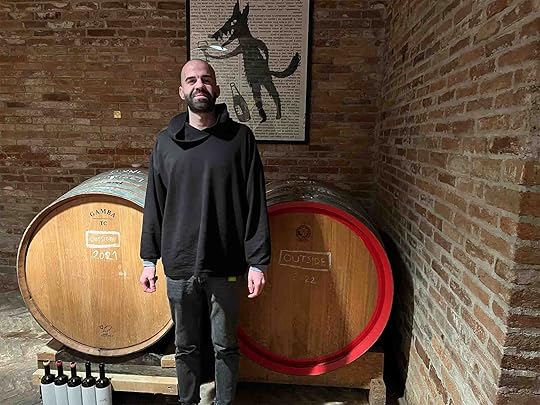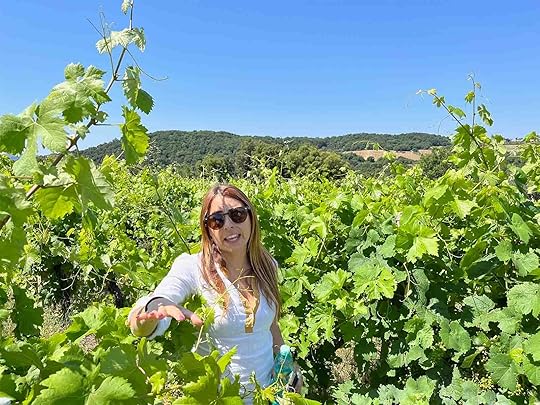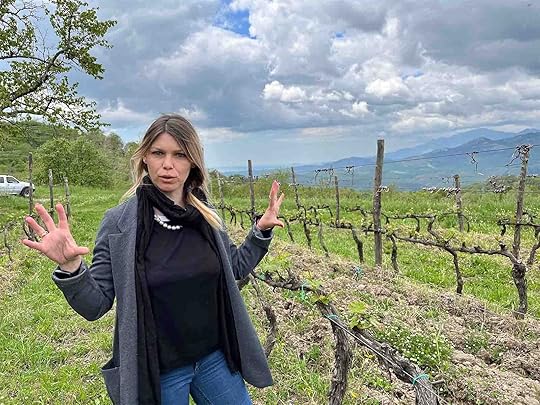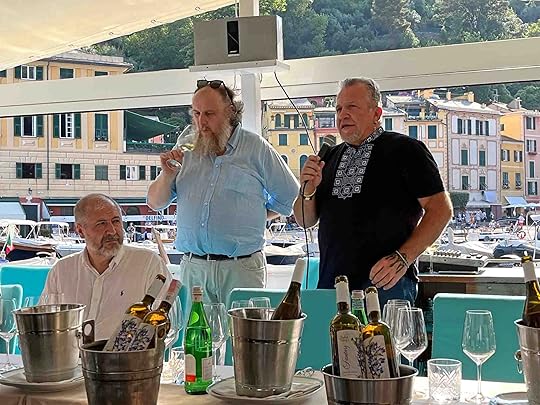Robert V. Camuto's Blog, page 3
March 31, 2024
Enrico’s California Dream

March 31, 2024
Enrico’s California Dream
Fed by the Blues, Dylan and Grunge — a Friuli native in New World wine
Returning from a recent trip to Sonoma wine country, I asked myself, “Where do Italian-style wines begin and end?”
Surely Italian winemakers using Italian grapes can make Italian-like wines in the right California terroir.
Italians and their descendants built much of the California wine country as we know it today from the 19th century and right through Prohibiton. Were it not for the American inferiority complex with all things French (read Bordeaux and Burgundy grapes), California’s wine scape would look a lot more Italian.

Arbe Garbe-Enrico Bertoz in Catie's Corner Vineyard of Mavlasia. Photo @ Robert Camuto
In the 21st century there’s been a revival – albeit a niche one – of relatively obscure Italian grapes in California from Sangiovese to Nebbiolo to Barbera to you name it.
These efforts often yield everything from “that’s interesting!” curiosities to really good wines.
Enrico Bertoz of the tiny label Arbe Garbe is part of that second category. He came to America from his native Friuli in the late 1990’s based on a dream fed by the Blues, Dylan, Kerouac and Grunge.
Working his way up from an L.A. dishwasher, he’s become a cult winemaker. Outside of his day job making French-International based wines for a Napa winery, he’s returned to his native roots: going deep into the character, expression and potential of Malvasia Bianca in Sonoma soils.
“It’s easy to make a sunny-side-up Malvasia, but I don’t want to make sunny-side-up Malvasia,” he says with the intensity of a seeker.
It’s worth your time to read about Enrico and he and wife Letizia’s Arbe Garbe adventure in the latest Robert Camuto Meets…(free) at wine spectator.com
March 17, 2024
Not the same old grapes

March 15, 2024
Not the same old grapes
What’s the future of wine look like?
This is a story that rings both sides of my chimes.
The problem: wine growing seasons are getting hotter and fungal and other diseases are having devastating effects on harvests.
Till now the solution has been to use chemicals including “organic” copper and sulfur that aren’t exactly great for soils and water sources.

Nicola Biasi in his high-altitude vinyeard planted to the resistant hybrid Johanniter. Photo @ Robert Camuto
One solution is the growing movement towards new resistant hybrid vines. It’s a brave new world because these hybrids crossing traditional varieties with American or Asian rootstock — don’t taste like their main components. They are different.
But wait a minute… I like my old wine varieties. With hundreds out there do we really need more?
In this week’s Robert Camuto Meets…. at winespectator.com, I talk with a Pied Piper of these so-called resistant varieties in Northern Italy’s Trentino, and discuss what could be the future of organic viticulture.
Can new hybrids make great wines?
February 29, 2024
Etna Third Wave

February 28, 2024
Etna Third Wave
The beat goes on with another volcanic generation
The most thrilling moment of my time writing about wine came 16 years ago when I began travelling regularly to Sicily — and specifically to Mount Etna.
There I discovered the beginnings of an Etna wine boom. In those heady days it seemed an alignment of stars brought together a small group of passionate pioneers to the mountain, who were looking for some kind of grail in Etna’s old but then-obscure wild and active volcanic terroirs.
Those high-altitude Nerello Mascalese–based reds, and ageworthy Carricante whites had the wine world agog — had a southern Burgundy been found? The hype triggered stage two: a boom of investment by established winemakers from across Sicily, Italy (with the most prominent example being Angelo Gaja) and even California.

Carla Maugeri with father, Renato, and sister Paola. Photo @Robert Camuto
I love Etna wines, partly because the small scale of the producers ensures a certain level of quality that seems here to stay
Now comes a third wave of younger winemakers — particularly Sicilians. They’ve studied the work of previous waves and are cultivating niches of their own.
To learn about some of the mountain’s most promising new winemakers including the Carla Maugeri (pictured above) who makes some of the mountains most daring whites, check out the latest Robert Camuto Meets… (free) at winespectator.com
January 30, 2024
Faro-out Sicilian wines

What about Faro?
Just about 40 miles north of the great volcano along the rough and dramatic Strait of Messina where the Tyrrhenian Sea meets the Ionian, Faro reds are based on the same grapes: Nerello Mascalese and Nerello Cappuccio. But Faro wines also have a splash of rare Sicilian spicy native Nocera and sometimes Nero d’Avola.
Also noteworthy is that alcohol levels tend to be slightly lower.
“In the wines of Faro, you taste the sea, the salinity,” Salvatore Geraci tells me over dinner in Messina as we compare vintages from his cult Palari winery in Faro with his vineyard on Etna. “In the wines of Etna, you taste the minerality — the fumé.” Gianfranco Sabbatino of Le Casematte in a vineyard that looks over the strait of Messina to mainland Italy
Gianfranco Sabbatino of Le Casematte in a vineyard that looks over the strait of Messina to mainland ItalyGeraci is the Messina architect who helped save the Faro appellation from extinction in the 1990s. And there are 17 others — mostly tiny properties cultivating a mere 400 vineyard acres in Faro.
These are colorful wines with it turns out some colorful producers. Late last fall I explored the area right down to a public agricultural high school, housed in a 16th-century monastery.
Read about in the latest Robert Camuto Meets… at winespectator.com.
January 17, 2024
Want to REALLY cultivate young wine drinkers

January 17, 2024
Want to REALLY cultivate young wine drinkers
How about shaking up the wine establishment with new blood?
Get a bunch of wine industry people together and they all decry THE major problem in the world today.
(Hint: It’s not war, population displacements, climate change, inflation or the prospect of our republics being replaced by Caesars – or Caesar’s Palaces).
The main problem for the wine world is that young people (Millenials and GenZ) aren’t drinking their fair share of wine!
But here’s what is not being discussed: The main enemy of wine is not the competition from G&Ts.

Alessandro Salvano of "Drink Wine Not Labels" in Italy's Piedmont
The main enemy of wine is its own entrenched wine establishment that has little room for young producers and growers.
I am not a youngster — having joined the Medicare set, but even I see it clearly: The wine world needs disruption. It always has thrived on it, starting before the “Judgment of Paris” nearly 50 years ago.
To explore this and go on a visit with me to the 28-year-old Piedmont producer of “Drink Wine Not Labels,” read my latest Robert Camuto Meets… column at winespectator.com.
December 21, 2023
How Cooperation might actually work in Italy!

December 21, 2023
How Cooperation might actually work in Italy!
Okay so this revolutionary idea took root in the German speaking Alto Adige, but it could work elsewhere
In Italy you hear it all the time – from wine region to wine region.
“The problem is we are Italian!” The lament goes. “We are individuals. We cannot cooperate! We cannot get anything done in a group.”
My advice: Stop whining already and look at the places where some degree of cooperation over a shared identity is actually working in wine.

Kurtatsch president Andreas Kofler (right) with export manager Harald Crost. Photo courtesy of Kellerei Cantina Kurtatsch
One such place is in the deep south on Sicily, where a few visionary and dedicated families have led the way towards quality wines, organic agriculture, and a much improved image.
The other pole of positive cooperation is in the way north near Austria – in the country’s (mostly German-speaking) South Tyrol aka Alto Adige.
Here in tiny Kurtatsch/ Cortaccia a group of small grape and apple farmers farmers of the local coop launched a revolution about a decade ago – looking beyond immediate market trends to future excellence.
I love the Kurtatsch story as a shining example for Italian wine and the wine world at large. Read it in the latest Robert Camuto Meets… at winespectator.com
A cooperative in the Italian Tyrol
November 27, 2023
“Chateauneuf du Pape of the Poor”

November 28, 2023
“Chateauneuf du Pape of the Poor”
In the heart of Sardinia, an intriguing wine and dynamic winemaker
Way back at the beginning of summer, I traveled to Sardinia. Far from the beaches and boutiques to the smack-dab center of the island, where it seems nothing has changed for centuries.
Here you see a polyculture mix sheepherding, cultivation of cork oaks, grain production and a bit of old vineyards that go into an intriguing local red blend called Mandrolisai.

Emanuela Flore of Bentu Luna in Sardinia
Among about 30 producers of the wine, is the young Sardinian enologist and winemaker at Bentu Luna, Emanuela Flore, who calls Mandrolisai “the Chateauneuf du Pape of the poor.”
Flore, who has the intensity and energy of a rocket, was recently elected president of the Mandrolisai appellation by her nearly-all-male peers.
That’s a good thing. If anyone can get Sardinia’s little-known reds in front of people – it’s her.
Bentu Luna is an interesting story making interesting wines. Read about it, Mandrolisai and Flore in the latest Robert Camuto Meets… at winespectator.com
November 10, 2023
Are you Susu?

November 9, 2023
Are you Susu?
The return of Susumaniello and other innovations liven up sleepy Puglia’s wine scene
I recently travelled to the heel of Italy’s boot and was stunned. Miles inland from Puglia’s booming sandy coastlines, the countryside of Salento (the lower part of the heel) was burned out and barren. Here, tens of millions of olive trees have succumbed to a bacterial blight over the last decade as officials wrung their hands with no surefire cure.
“I couldn’t stay here and just watch everything die,” says Antonio Intiglietta the Puglian native and Milan entrepreneur, who has replanted some of those stony olive orchards to vineyards. After studying soils, a Burgundy wine nursery recommended Bordeaux red varieties Cabernet Sauvignon, Cabernet Franc and Petit Verdot for his Tenuta Liliana.
“I am convinced that, in these soils with the sun and wind and the water here, you can do something great,” says his Tuscan winemaker Carlo Ferrini.

Tenuta Liliana owner Antonio Intiglietta in a Bordeaux blend vineyard
Puglia’s wine scene is becoming more and more interesting these days – meaning elegant wines that defy the Puglian image of overripe sweet Primitivo (aka Zinfandel).
At Masseria Li Veli, for example, the Falvo family is exploring native easy-drinking varieties like Susumaniello (“It’s a democratic wine – easy to drink, but not simple,” says Alessandro Falvo)
These are interesting wines that flow from an interesting scene.
Read about it in my latest Robert Camuto Meets… at winespectator.com

Alessandro Falvo in Masseria Li Veli's winery. From 2022 part of its Susumaniello red is aged in clay amphorae.
October 5, 2023
The return of a great Southern Italian red

October 5, 2023
The return of a great Southern Italian red
After years of struggle and renewal, Galardi is back
Starting 40 years ago and running more on dreams than business – tiny Campania red wine producer Galardi – is a tale of tragedy and triumph.
It’s a story as romantic as Southern Italy itself.
Do read the full story of the creation and demise of creator Roberto Selvaggi, the Renaissance by daughter, Allegra, and the details of its new deal and return to the US market in the latest Robert Camuto Meets…

Allegra Selvaggi of Galardi wines. Photo @ Robert Camuto
September 21, 2023
How’d this Piedmontese white grape get to Southern Ukraine’s front?

September 21, 2023
How’d this Piedmontese white grape get to Southern Ukraine’s front?
Timorasso has gone from near extinction to a hot somm secret. Now it’s leaking out to the world in some disparate places.
So I’ve been fairly quiet this summer: baking in the heat, grilling, drinking white wine, swimming, thinking and reading (carefully moving through Alexis de Tocqueville’s 1830’s amazingly wise and prescient “Democracy in America”)
I have gotten out on the trail. So let me tell you about one of my recent stories. Piedmont geeks have for years known about Timorasso – the Southern Piedmont’s intriguing mouth-filling white of the Derthona hills.

At a recent Timorasso tasting : Bisso Atassanov (right) and Colli Tortonesi pres, Gian Paolo Repetto (left) and tasting host Diego Sorba (center). Photo @ Robert Camuto
The background is that grape has come back from near extinction in the 1980s (thanks to Walter Massa of Vigneti Massa) to fuel an exciting wine scene. Now the scene is beginning to spill out to the wider wine world. That’s where Ukraine, Sonoma and maybe your next outing to wine shop fit in.
The Piedmont is so well known for potent reds starting with Barolo and Barbaresco, that its fitting Timorasso/Derthona is a naturally big white.
So big that extract analysis puts it closer to red wine. This is not anonymous juice – it can be crisp, saline structured and mineral and age like Riesling.
And so big, it caught the eye of the experimental Beykush winery Ukraine. While I am not going to the war front anytime soon, I did get to taste the wines in a lineup of Derthona versions at a recent tasting in Portofino (tough job I know!) It’s also been grafted by Sam Bilbro of Idlewild Wines in Sonoma who will release his first bottles this fall.
Do read all about Timorasso-mania it in my latest Robert Camuto Meets… at winespectator.com

The stunning Black Sea vineyards of Beykush in Ukraine. photo @ Beykush



